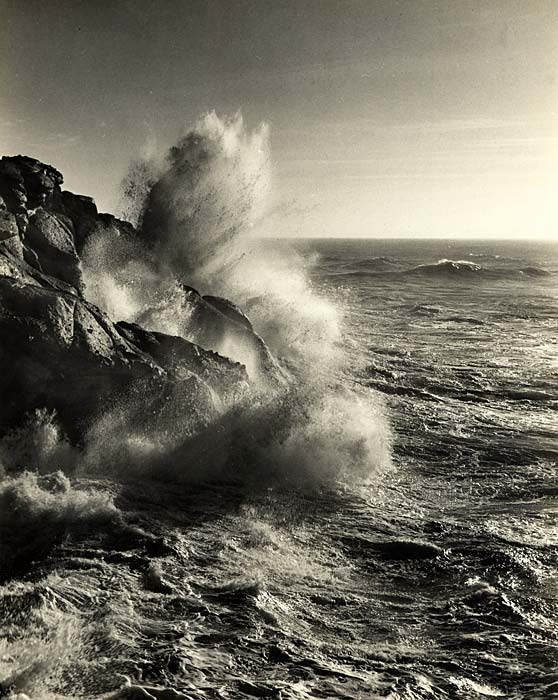 The Oregon Coast in 1940.
Enlarge map.
The Oregon Coast in 1940.
Enlarge map.
 Surf hitting rocks near Depoe Bay (1614).
Enlarge image.
Surf hitting rocks near Depoe Bay (1614).
Enlarge image.
U.S. Highway 101 closely parallels the rocky Oregon Coast, affording striking views of sea and shore. From as early as 1543, when Ferrelo, under orders from the Spanish viceroy in Mexico City, may have pushed as far as Oregon in search of the mythical Straits of Anián (which were supposed to provide a passage across the continent), until long after 1792, when Capt. Robert Gray entered the mouth of the Columbia River and Lieut. William Broughton explored it, these shore waters were the scenes of perilous adventure.
South of the tidal estuary of the Columbia, the salt marshes and low sand spits of the northwest rim of the state, cliffs crowd close to the ocean. Construction of a motor road along the coast, first called the Roosevelt Military Highway and later the Oregon Coast Highway, was approved by Oregon voters in 1919 after being championed by Benjamin F. Jones, who served at various times as mayor of Newport, Toledo, and Independence, as well as member of the Oregon State Legislature. The highway was completed in 1932. Only then did real development along the coast begin. Long isolation gave seaboard towns a certain individuality, though they share the characteristics of villages on any coast subject to violent storms.
 Fishing at Astoria Derby (2679).
Enlarge image.
Fishing at Astoria Derby (2679).
Enlarge image.
Summer cottages here and there are trim and brightly painted, but the majority of houses have a haphazard look. Each has been placed where its owner thought he could gain the most protection from wind and waves. Most of the weatherboarding (locally called shiplap) and shingles are a uniform silver gray. Formerly, shingle "seconds" could be had at the mills without cost, or for very little, and many coast homes were covered with them. Shingles over shiplap were considered the best walling though discouraged coasters insist that a weatherproof house simply cannot be built--the wind will whip rain through the most cleverly joined and mortised walls. The same wind tears loose clapboards and shingles, so every house more than a few years old is bound to show marks of repeated repairs, unless the owner has given up the struggle.
Another characteristic of the coast are buildings standing on piling over inlets. While some villages ramble over flats, many are huddled in the lee of a steep hill or cliff. There are even occasional houseboat colonies.
In spite of summer fogs and winter rains, the stream of visitors to the region is growing steadily; the physical grandeur of the terrain and the smell of evergreen forests tanged with salt air and heightened by mist form an exhilarating combination.